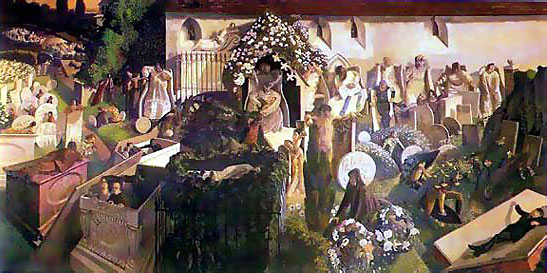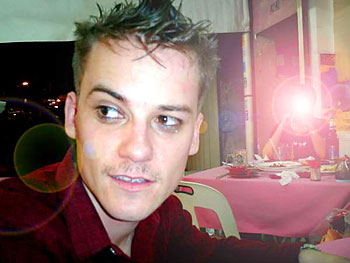
| Jacket 35 — Early 2008 | Jacket 35 Contents page | Jacket Homepage | Search Jacket |
The Internet address of this page is http://jacketmagazine.com/35/r-kenneally-rb-aiken.shtml
Cath Kenneally
Ci Vediamo
reviewed by Michael Aiken
39pp. Little Esther Books. 0 9586261 9 7 paper
This review is about 7 printed pages long. It is copyright © Michael Aiken and Jacket magazine 2008.
1
Adelaide-based Cath Kenneally’s Ci Vediamo is a slim volume of 16 poems, mostly a page or two in length, set in a few specific European cities, plus one poem in North America and two or three in Australia, all apparently based on a single journey. The book opens with a section in Rome followed by briefer stints in Ireland and England, with the equivalent of a stop-over in the U.S. prior to the close back in Australia.
paragraph 2
Anyone who has written or read poetry based on travel experiences will be well aware of a major potential challenge facing such writing: how to transpose what may have been exciting, interesting and wholly new experiences for the writer into engaging writing for readers to whom the subject matter may not be so fresh or new.
3
Take the poet’s use of places, customs and language, all of which feature heavily in Ci Vediamo: is she simply listing things that are in themselves engaging, irrespective of how engaging her writing is? There are certainly some poems in this book, or moments within poems, that do little other than delight in fairly direct description of a foreign locale
4
I feel I’ll remember street names for years
the walks and parks – Celimontana,
frothy with weddings,
Orti Scipione, dusty and loveable
tram 3 to Baths of Caracalla
past S Lorenzo, through the Gate
along Via Appia Antica where
you still find large villas, open space
stone walls, overhanging branches
plaques to say Garibaldi entered
such and such an opening a
vicino...
– Finalmente
5
One of the poems that most successfully balances its excitement at being in a foreign city with an awareness that travel to that place, and travel in general, aren’t so new to some readers, is her Roma haiku, where every word contributes something to the picture of a traveller new on the ground, and their fresh-faced excitement
6
all day
new shoes on cobbles
looking first left, then right
7
Without labouring the point or making pretension to profundity, this, the opening poem, sets a tone of light self-deprecation mixed with enthusiasm that makes it easier to forgive what few gauche moments occur later.
8
The verse in this book is not greatly concerned with disruption of form nor other surface innovation; it reads more like a series of quick sketches around a personal foray into international tourism, the engaging aspects of which are the cumulative effects of relatively brief encounters with other cultures. Slightly longer than pit stops, these glimpses into cultures already broadly familiar to a Western audience work well when they make no attempt at educating or informing, instead focusing on the anecdotal, incidental encounters of the traveller, like London Haiku
9
bleary eyed busker boards the Tube
‘Sorry I’m late, folks,’
and starts to play
10
Most of the Italy poems are very suggestive of personal notes-to-self: general historical details regarding particular buildings visited and the art they house, brief descriptions of plazas and piazzas; take the first two stanzas of Finalmente
11
Last chores, last night
leaving Monday – Terry for dinner
expat gardener at the British Ambassador’s
worlds away from Fitzroy Gardens
Carlo & Suzie staying,
direct them to Wash ‘n Dry
Colosseum, Palatine, Vatican
we’re the experts now
12
and this tone permeates the entire book, culminating in a near-shopping list finale.
13
In keeping with the diaryness of the book, a lot of individual lines seem to bubble out of nowhere, random thoughts amongst the hectic tour, like the erratic and somewhat ill-informed reference in Sacro Sangue to progesterone as ‘boy-germs’.
14
The intrusion and interaction of cultures, across geography, eras and political circumstances, generates some of the most interesting situations in this poetry. In Dulce Domum, for example, Kenneally almost immediately appropriates an ancient art
15
Give me Nile monsters,
dippy dolphins,
fish-looting moggies
Santa Costanza, your pre-Christian dome
loaded with unabashed plenty
sheaves & fountains
pheasants and peacocks
the artist immersed
in the lip-smacking moment
in my head I’m commissioning
frond-tailed lyrebirds
to prance the length of our hall
doves and delphiniums
all round the bed,
a seahorse mosaic
in a tessellated bathroom
16
reducing a millennia-old monument to something out of a house and garden magazine.

The Resurrection, Cookham, by Stanley Spencer
17
She later puts this colloquialising technique to interesting ekphrastic effect, deflating yet intensifying the bizarre horror of Stanley Spencer’s ‘Resurrection’
18
They’re climbing out from under slabs
chubby and clothed
in florals and tweeds, cardies and singlets,
children hauling parents by the hand
back into the light of
the green English countryside
19
Her use of ‘cardies’ in particular adds something routine and domestic to what is otherwise a scene of grotesque unnature, with lines like ‘tubular limbs/ tight-packed flesh’ and ‘not euphoric/ they crawl over the ground/ like fat blind worms’ illuminating the supernatural mundaneity of Spencer’s construction of the resurrection.
20
Amongst the casual tourism and indulgent sightseeing, the theme of post-colonial Australia and its relationship with the Old World whence (and of) it came recurs – Oggi’s comparisons of a botanical garden in Italy with an Italian botanical garden in Australia drawing particular attention to some of the associated difficulties of an antipodean writer living and working in a European tradition –
21
the Australian Bed has one leptospermum
in authentic red clay, girt
by empty holes
on the other side of the world
Adelaide’s Orto runs to
an Italianate water garden, formal
pond, long, narrow, cypress-framed,
flattop hedges, disappearing-perspective
paths, painstakingly correct homage
to our magnetic north of beauty
do they think of us like our flora
gangly, hardy, thick-skinned, dry?
22
highlighting not only a post-colonial’s self-consciousness but the constructedness of one culture’s image of the other.
23
In the Ireland section Kenneally goes on to mention returning to the grand buildings her ancestors turned their backs on in Ireland ‘despising the micks and the English equally’ for Adelaide, that place whose reciprocal image in the orto botanico is one ‘gangly, hardy, thick-skinned, dry’; the poet returning, art reviewing the old world, wanting to replicate it back home ‘in a tessellated bathroom’, conscious of the incomplete image of the post-colony in the old world’s eyes – this poetry isn’t simply about the differences of culture a traveler sees: it’s a sizing up, a rooster-like mock-posturing by the colonies under the gaze of that Old World.
24
Most of this book is very chatty, even jokey – this is the second stanza of Faniculle
25
Roma, showcase of church fashion
an ecclesiastical catwalk to rival Fellini’s
no doubt unnoticed nuns in mufti
are out there, but we goggle at
the masses meandering in medieval garb
flocking with the pigeons around the great churches
26
The chattiness can grate at times but, tempting as it may be to condemn Ci Vediamo’s suburban home renovations based on sacred art as unnecessarily irreverent or disrespectful, such a reaction does not address the paradox highlighted by Kenneally’s treatment of the subject: that irreverent suburban dilettantes are clearly catered to by and enticed to attend these venerable sites, as indicated by the theme park vibe of the Barberini palace in Millefiori
27
‘Goya!’ is in the Bee for Barberini palace
bees etched in stone upstairs and down, inside and out
Borromini stairs, perhaps, special anyway
left at first landing for Goya, right
for Barberini Collection, the ticket is for both
Goya’s naïve up close – flash,
splashy
28
Beneath the flippant air (or perhaps within it) is an intuitive dialectical engagement with tourism as a cultural practice, as a component of cultural interaction, hence the question posed at the close of Oggi:
29
do they think of us like our flora
gangly, hardy, thick-skinned, dry?
30
At times it would seem Kenneally wants to colloquialise the mythical, to demystify the old world. It’s in evidence in her particular use of Italian, throwing in isolated verbs and nouns as if they were English, not incorporating the Italian language into her English poetry but simply making individual Italian words part of her English, in much the same way she continues to live a suburban/urban Australian life using Rome as her urban landscape.
31
The Irish section of the book has more of the chatty notes-to-self-ishness of Finalmente, with some pleasing, unassuming but striking images of the surrounding landscape bouncing off an account of a journey into the speaker’s family history, as in this from Cobh:
32
once frequented by John Wilkinson,
who left Enniscorthy for Adelaide
Wesleyan to his bootstraps,
in 1837
despising the micks and the English equally
all his life wrote back urging family to come
while he fathered a line that led
to Peter, my mother’s father
the tide flows in over mud
we skip the heritage museum
the haze over the harbour
merges out yonder with deep waters
[...]
we rattle back across the causeway
gorse and white houses
the tide spreads silver
over miles of ooze
33
Despite the book’s brevity, Kenneally manages to establish a particular atmosphere and initiate numerous themes, themes she even finds time to question and develop. Consider On the Line
34
my grandmother
pegging clothes onto
our Hills Hoist
asks ‘really,
would you really
marry a black?’
35
This poem doesn’t fit with my otherwise servicable reading of the book as a travelogue, and perhaps that was Kenneally’s plan – to disrupt readers too literally taking Ci Vediamo to be a series of holiday observations in verse; aside from the setting – ‘our Hills Hoist’ suggesting a return to Australia as well as home – and its positioning, lodged between two poems set in London, On the Line is far removed from the casual tourist observations of most of the book. Situated as it is in the English phase of an anglo-celtic ancestral pilgrimage by a post-colonial, it invites interrogation of the relationships between colony/post-colony, post-colonials and the colonising culture, while problematising attempts to attribute vices of imperialism like racism to the Old World alone.
36
As with many works of art, Ci Vediamo’s greatest strength is also its weakness: it is, for the most part, brief, casual, dashed off. The book readily carries the reader through a sequence of light, self-effacing holiday encounters, self-reflexive and critical at times, but certainly working to entertain and distract more than to challenge or compel.

Michael Aiken
Michael Aiken is a security professional working in the New South Wales Public Service in Sydney and newly appointed default audio engineer for Darlington primary school’s Parents and Citizens committee. Most recently his writing has appeared in unusual work, Shampoo, Foam:e and snorkel.